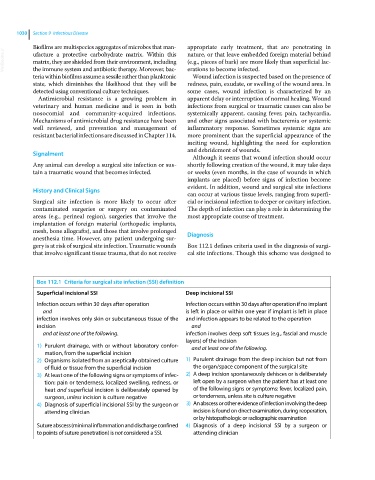Page 1092 - Clinical Small Animal Internal Medicine
P. 1092
1030 Section 9 Infectious Disease
Biofilms are multispecies aggregates of microbes that man- appropriate early treatment, that are penetrating in
VetBooks.ir ufacture a protective carbohydrate matrix. Within this nature, or that leave embedded foreign material behind
(e.g., pieces of bark) are more likely than superficial lac-
matrix, they are shielded from their environment, including
the immune system and antibiotic therapy. Moreover, bac-
Wound infection is suspected based on the presence of
teria within biofilms assume a sessile rather than planktonic erations to become infected.
state, which diminishes the likelihood that they will be redness, pain, exudate, or swelling of the wound area. In
detected using conventional culture techniques. some cases, wound infection is characterized by an
Antimicrobial resistance is a growing problem in apparent delay or interruption of normal healing. Wound
veterinary and human medicine and is seen in both infections from surgical or traumatic causes can also be
nosocomial and community‐acquired infections. systemically apparent, causing fever, pain, tachycardia,
Mechanisms of antimicrobial drug resistance have been and other signs associated with bacteremia or systemic
well reviewed, and prevention and management of inflammatory response. Sometimes systemic signs are
resistant bacterial infections are discussed in Chapter 114. more prominent than the superficial appearance of the
inciting wound, highlighting the need for exploration
and debridement of wounds.
Signalment
Although it seems that wound infection should occur
Any animal can develop a surgical site infection or sus- shortly following creation of the wound, it may take days
tain a traumatic wound that becomes infected. or weeks (even months, in the case of wounds in which
implants are placed) before signs of infection become
evident. In addition, wound and surgical site infections
History and Clinical Signs
can occur at various tissue levels, ranging from superfi-
Surgical site infection is more likely to occur after cial or incisional infection to deeper or cavitary infection.
contaminated surgeries or surgery on contaminated The depth of infection can play a role in determining the
areas (e.g., perineal region), surgeries that involve the most appropriate course of treatment.
implantation of foreign material (orthopedic implants,
mesh, bone allografts), and those that involve prolonged Diagnosis
anesthesia time. However, any patient undergoing sur-
gery is at risk of surgical site infection. Traumatic wounds Box 112.1 defines criteria used in the diagnosis of surgi-
that involve significant tissue trauma, that do not receive cal site infections. Though this scheme was designed to
Box 112.1 Criteria for surgical site infection (SSI) definition
Superficial incisional SSI Deep incisional SSI
Infection occurs within 30 days after operation Infection occurs within 30 days after operation if no implant
and is left in place or within one year if implant is left in place
infection involves only skin or subcutaneous tissue of the and infection appears to be related to the operation
incision and
and at least one of the following. infection involves deep soft tissues (e.g., fascial and muscle
layers) of the incision
1) Purulent drainage, with or without laboratory confor- and at least one of the following.
mation, from the superficial incision
2) Organisms isolated from an aseptically obtained culture 1) Purulent drainage from the deep incision but not from
of fluid or tissue from the superficial incision the organ/space component of the surgical site
3) At least one of the following signs or symptoms of infec- 2) A deep incision spontaneously dehisces or is deliberately
tion: pain or tenderness, localized swelling, redness, or left open by a surgeon when the patient has at least one
heat and superficial incision is deliberately opened by of the following signs or symptoms: fever, localized pain,
surgeon, unless incision is culture negative or tenderness, unless site is culture negative
4) Diagnosis of superficial incisional SSI by the surgeon or 3) An abscess or other evidence of infection involving the deep
attending clinician incision is found on direct examination, during reoperation,
or by histopathologic or radiographic examination
Suture abscess (minimal inflammation and discharge confined 4) Diagnosis of a deep incisional SSI by a surgeon or
to points of suture penetration) is not considered a SSI. attending clinician

